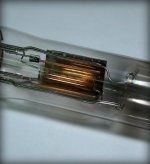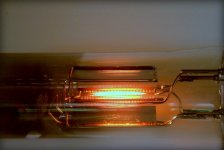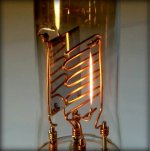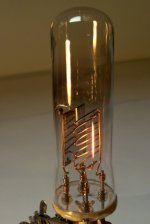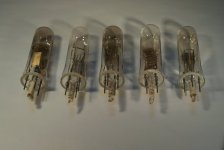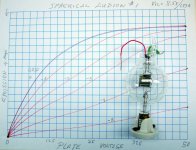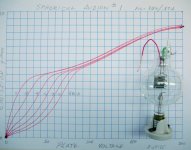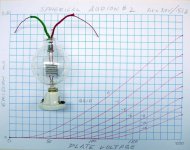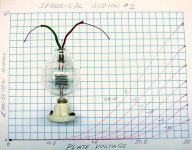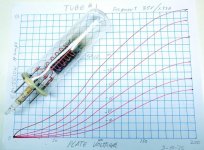Usually, a curve tracer is useful for testing triode vacuum tubes. I've cobbled together a few different ones that are aimed at testing semiconductor devices. The types that are not stand alone models (like those from Tektronix) can be found on eBay quite cheaply. The Heathkit, B&K Dynascan, and Leader models all have a FET mode setting and can be useful for triode testing. An o'scope with an XY display is all that's needed to view the family of curves. A limitation for testing triodes with these instruments is that the voltage and current ranges are limited and a camera is usually need to get a permanent copy of the test results.
My curiosity got the best of me last week and I decided to take curve tracing to the next level. I have a collection of assorted handmade triodes that were built back in the mid 90's and wanted to see how they perform after sitting in a drawer for 20 years. The homemade single wing spherical Audion replicas were of interest because they had no getters installed. They were intended to look like the real thing, but processed to a much higher level than the originals. A long bake-out at 400º C and a vacuum in the range of mid 10^-7 Torr was achieved before the tubes were tipped off from the manifold. No getters were used.
To make the tests more interesting the spherical Audions were tested against a homemade design that used the same sort of geometry, but constructed from things around the lab. As a means of dispensing with the need for doing any glass blowing, the stem assembly and bulb were sealed together with epoxy. This joint was now the weak link in the processing procedure, but offered a way to actually build a triode on the kitchen table, as it were. The epoxy limited the bake-out temperature to 150º C, at the seal, but the rest of the tube could be baked at 350º C for any length of time. This was all done with a compact 2 zone oven. The construction was of the wire wrapping method which worked out well and eliminated the need for spot welding. To overcome the lack of sufficient bake-out temperature, getters were installed in the epoxy sealed tubes.
The desire to be able to use test voltages up to 400V and plot out the data for hard copy required a setup that could do more that the typical bench top curve tracers mentioned above. The new arrangement of test gear has a considerably larger footprint, but is much more dynamic that the alternative.
It was reassuring to see that the spherical types still were under high vacuum even without the use of any getters. All of the custom wire wrapped designs had used up all the original getter material, but some could sill operate as triodes up to 400V without breaking down.
I could try to post some of the plots if anyone is interested in these tests. So far I haven't been able to find any characteristic curve sets for the original single wing Audions on the net, but if anyone has a link to them I'd like to see what others have done.
My curiosity got the best of me last week and I decided to take curve tracing to the next level. I have a collection of assorted handmade triodes that were built back in the mid 90's and wanted to see how they perform after sitting in a drawer for 20 years. The homemade single wing spherical Audion replicas were of interest because they had no getters installed. They were intended to look like the real thing, but processed to a much higher level than the originals. A long bake-out at 400º C and a vacuum in the range of mid 10^-7 Torr was achieved before the tubes were tipped off from the manifold. No getters were used.
To make the tests more interesting the spherical Audions were tested against a homemade design that used the same sort of geometry, but constructed from things around the lab. As a means of dispensing with the need for doing any glass blowing, the stem assembly and bulb were sealed together with epoxy. This joint was now the weak link in the processing procedure, but offered a way to actually build a triode on the kitchen table, as it were. The epoxy limited the bake-out temperature to 150º C, at the seal, but the rest of the tube could be baked at 350º C for any length of time. This was all done with a compact 2 zone oven. The construction was of the wire wrapping method which worked out well and eliminated the need for spot welding. To overcome the lack of sufficient bake-out temperature, getters were installed in the epoxy sealed tubes.
The desire to be able to use test voltages up to 400V and plot out the data for hard copy required a setup that could do more that the typical bench top curve tracers mentioned above. The new arrangement of test gear has a considerably larger footprint, but is much more dynamic that the alternative.
It was reassuring to see that the spherical types still were under high vacuum even without the use of any getters. All of the custom wire wrapped designs had used up all the original getter material, but some could sill operate as triodes up to 400V without breaking down.
I could try to post some of the plots if anyone is interested in these tests. So far I haven't been able to find any characteristic curve sets for the original single wing Audions on the net, but if anyone has a link to them I'd like to see what others have done.
Vincent - Thanks for your interest in the DIY triodes. Here are some photos of the tubes that I've tested lately. These were all sealed with Hysol 1C epoxy. There are some that have spot welded elements. Others are wire wrapped. Either method works well.
Attachments
Here are a few characteristic curves from a sampling of homemade tubes. These curves are interesting to me as a diagnostic tool. I tend to over-enjoy doing tests and measurements when the chance arises. Hopefully these plots will be of interest to others.
Attachments
Here are a few characteristic curves from a sampling of homemade tubes.
These curves are interesting to me as a diagnostic tool.
Great work. No doubt you'll get requests for custom designed tubes now.
MR - Thanks for the question. The sphericals were blown from straight wall soft glass tubing. It's very difficult to work with compared to hard borosilicate glass. All of the tubes I build now are using hard glass. I'm building a small glass lathe that is a re-engineered 8 X 12 wood lathe. There's nothing easier than to epoxy the bulb to the stem assembly, but it makes it impossible to get the bake-out temperature up to where it should be. The glass lathe will allow the seal to be all glass and will therefor be safe at much higher temperatures for processing.
There's nothing too unusual about being able to routinely achieve a pressure in the 10^-7 Torr range, particularly on a small system, provided that the system is 'clean and tight'. There are some variations of the term 'clean' used by many high vacuum hobbyists. On the other hand, 'tight' means only on thing; no leaks! By leaks I mean that there is no air coming from the outside of the system. Depending on the system builders version of 'clean', the most common problem hindering good performance is a 'virtual' leak. These occur when the parts used to build a system have residual films of various high vapor pressure deposits such as oils and finger prints on the inside walls. Even if there are no real leaks, the out-gassing of virtual leaks can stall out the high vacuum pump at some pressure that can be disappointingly high. All of this is assuming that the system has been designed for the highest conductance to the high vacuum pump.
This info is, of course, a simplified and condensed version of good high vacuum technique.
This info is, of course, a simplified and condensed version of good high vacuum technique.
- Status
- This old topic is closed. If you want to reopen this topic, contact a moderator using the "Report Post" button.
- Home
- Amplifiers
- Tubes / Valves
- Testing DIY triodes
